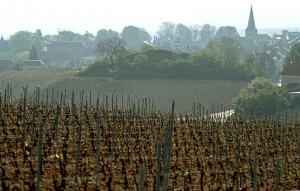 Champagne comes in various forms – brut, extra brut – even 'zero dosage' – non vintage, vintage, special cuvée, blanc de noirs, and blanc de blancs – literally 'white from white'. The colour refers to the grape varieties used in making the wine. Generally, there are three varieties used in the making of Champagne – Pinot Noir and Pinot Meunier (both black grapes) and Chardonnay, the only white grape variety used. A basic non vintage Champagne is an assemblage (blend) of different pressings which are made up from different parcels of vines which might come from anywhere within the Champagne appellation, different varietals and, even, different years. This is is also the case with blanc de blancs which, in its purest form, will comprise the pressings of Chardonnay from a small number of vineyards or, even, a mono-cru (one single vineyard). The characteristics of Champagne made exclusively of Chardonnay are quite different from wines composed of the other variations because Chardonnay, in general, produces a very fine style of wine with strong citrus flavours which may include tastes of lime to even grapefruit, also almond, but the almonds can be sweet and roasted or fresh and slightly bitter. It possesses enormous finesse coupled with good minerality and acidity with the potential to age well. Of course, there are also variations brought by the terroir, the vinification and rearing (élévage) of the wine – whether oak barrels are used and how – and the intentions of the winemaker in determining the style of wine they wish to produce.
Champagne comes in various forms – brut, extra brut – even 'zero dosage' – non vintage, vintage, special cuvée, blanc de noirs, and blanc de blancs – literally 'white from white'. The colour refers to the grape varieties used in making the wine. Generally, there are three varieties used in the making of Champagne – Pinot Noir and Pinot Meunier (both black grapes) and Chardonnay, the only white grape variety used. A basic non vintage Champagne is an assemblage (blend) of different pressings which are made up from different parcels of vines which might come from anywhere within the Champagne appellation, different varietals and, even, different years. This is is also the case with blanc de blancs which, in its purest form, will comprise the pressings of Chardonnay from a small number of vineyards or, even, a mono-cru (one single vineyard). The characteristics of Champagne made exclusively of Chardonnay are quite different from wines composed of the other variations because Chardonnay, in general, produces a very fine style of wine with strong citrus flavours which may include tastes of lime to even grapefruit, also almond, but the almonds can be sweet and roasted or fresh and slightly bitter. It possesses enormous finesse coupled with good minerality and acidity with the potential to age well. Of course, there are also variations brought by the terroir, the vinification and rearing (élévage) of the wine – whether oak barrels are used and how – and the intentions of the winemaker in determining the style of wine they wish to produce.
Champagne houses are allowed to add qualitative definitions relating to the vineyards from when the grapes are selected – Premier Cru and Grand Cru. These classifications which date back to the early 20th century provide that Champagne houses which have used grapes from areas so designated in the proportions required may add these descriptors to their labels. Whilst generally it is a good system, one should be aware that there are some excellent Champagnes which don't indicate this on their label (even if they source a large proportion of their grapes from these areas), because their label (their brand) is more important than adding this qualification. Also, the classification is based on villages rather than individual vineyards where, inevitably, some are better situated than others. It is also possible that even the supposedly less highly rated Premiers Crus villages are capable on a good day, in producing grapes which rival or even exceed the qualities of those of the Grand Crus.
Champagne, its terroir, manufacture, nomenclature, and taste is a veritable tapestry which repays the interest and investigation one is prepared to invest.
Blanc de blancs – Vintage
These are naturally the top wines of the producers, made with grapes from only the better years and from terroirs where the crops were the best. 1999 was a difficult year in Champagne but it goes to show when the conditions are mastered what can be produced. Both Amour de Deutz and Exception (Mailly) found a very fine expression of Chardonnay and doubtless the difficult conditions helped, even keeping the acidity in check. Interestingly, the best wines here did not only come from the 2002 vintage which really was one of the best in Champagne in the last ten years, although Roederer's vintage 2002 is superb. Producers can still make excellent wines in average years as so much will depend on where the problems occur across the appellation – for example, violent rain storms, hail (particularly damaging in 2000). In 2003 Champagne suffered like everywhere else with excessive heat in the summer and it was a difficult year to make a wine with great finesse and elegance so de Sousa are to be commended for their effort.
See our tasting notes appended at the end of this article.










